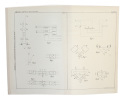"BLUMLEIN, ALAN DOWER.
Improvements in and relating to Sound-transmission, Sound-recording and Sound-reproducing Systems. [British Patent] Number: 394,325. [Date of Application, 14th December, 1931. No. 34,657 / 31 - Complete left: Nov. 10, 1932. Complete accepted, 14th Jun... - [THE INVENTION OF STEREO]
[London, Eyre and Spottiswoode], 1933, 14th June. 8vo. Disbound. Stamp to p. 1. 22 p + 1 folded plate.
Reference : 49181
Scarce original printed patent for the world's first stereo sound-recording system thus revolutionizing music recordings, radio broadcasting and cinematographic recordings. The present patent is considered ""a bible for sound engineers [and] it pre-empts all further useful reasoning on the subject"" (New Scientist). ""It is a classic patent in the history of electrical engineering"" (British Library, Patent Blog)"" it was more than a century ahead of its time, as stereo recordings did not become the standard until the 1950'ies. Blumlein furthermore anticipated many of the thoughts and techniques behind Dolby Pro-Logic. Blumlein's patent is not only a milestone in the history of engineering, unlike most other patents it reads like a text book and is still by most sound engineers considered the best source text on how stereo works.On several occasions, Blumlein explained that a blind person sitting in the cinema would be able to point out exactly where the actor was on the screen with his system. He called this system 'Binaural Sound', from the human factor of having two ears by which we hear sound. Today it is better known as Stereophonic or 'Stereo' Sound.""In 1931 Blumlein's GB 394325 was applied for by Electric and Musical Industries Limited, later better known as EMI. It enabled the first single track, two channel gramophone recordings. It is a classic patent in the history of electrical engineering, and has the then extraordinary number of 70 claims (half a dozen was normal at the time). The story goes that he thought of the basic idea when he and his wife were at the cinema. The early ""talkies"" had a single set of speakers which meant that the actor might be on one side of the screen while his voice seemed to come from the other side. Blumlein declared to his wife that he had found a way to make the sound follow the actor across the screen.Blumlein is credited with 128 patents in a working life of 18 years (he was only 38 when he died, while engaged in radar experiments in a Halifax bomber). A true polymath, he worked in virtually every field of electrical engineering."" (British Library). ""The work conducted at E.M.I. is best preserved through the writings of one its researchers and one the founding fathers of stereo recording, Alan D. Blumlein. The patents of Blumlein, especially the classic ""Specification 394,325"" accepted in 1933, still inform and challenge theorists and recording TdC-6 techniques to this day. Blumlein's basic approach to stereo relied on the realization that simple level differences at the loudspeakers would translate into both level and phase differences at the ears, thus better approximating the way sound is heard naturally (more on this topic later). To create only level differences at the loudspeakers, Blumlein had to capture only level differences at the microphones. A coincident pair of directional microphones, with no time delay between either channel, can best provide such information. For this reason, the stereo configuration that today bears Blumlein's name is a coincident pair of pure pressure gradient figure-8 microphones, the patterns of which are highly directional."" (Clercq, A More Realistic View of Mid/Side Stereophony)Years would pass before enthusiasts at EMI would resurrect Binaural sound and when they did, Blumlein's work initiated a revolution - a revolution which is still in process: New methods and techniques are constantly being developed in order to make sound recordings sound as lively and real as possible.
Bookseller's contact details
Herman H. J. Lynge & Son
William Schneider
Silkegade 11
1113 Copenhagen
Denmark
+45 33 155 335
Payment mode
Sale conditions
All items may be returned for a full refund for any reason within 14 days of receipt.
 Write to the booksellers
Write to the booksellers


